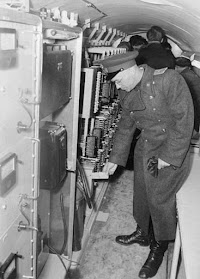 |
| Electronics racks in the tunnel |
It became a joint operation between US and British intelligence. Operation GOLD was lead by the CIA, and Operation STOPWATCH by MI6. Construction planning started mid 1953. The US Engineering Corps would dig the 1500 feet (500 m) tunnel underneath the East German border and the British would drive the vertical shaft towards the cables, only 27 inches (68 cm) beneath the surface alongside a highway, and provide the tapping of the cable. Some 3,000 tons of sand had to be disposed without border guards noticing it. A warehouse project near the tunnel was set up as cover and the tunnel dirt was disposed in its basement. All planning and work had to be done in absolute secrecy, with as little as possible people involved. Meanwhile, linguists in Russian were recruited and trained.
In August 1953, tunneling started, right beneath border guards, forcing engineers to halt and keep silent, each time the guards walked over. By March 1955 the tunnel and the tap room, a large air-conditioned sealed room with electronics, were completed. The three main Soviet landlines were tapped, the signals preamplified in the tap room and sent further down the tunnel for recording. It was a marvel of planning and engineering. The cables carried 1200 channels. 28 telex circuits and 121 voice channels were recorded continuously, transcribed and analysed.
 |
| Soviets inspect the tunnel source: Bundesarchiv |
Nonetheless, on April 21, 1956, after eleven months of eavesdropping,
the tunnel was discovered. Apparently by accident, when East Germans dug
up a faulty cable. However, later on, British intelligence discovered
that George Blake, an MI6 officer who was involved from the earliest
beginning of the planning, had been recruited by the KGB as early as
1952. He informed his Soviet contacts as soon as the final location of
the tunnel was planned. The tunnel and the mole, what's in a name.
In the end, the question remains how successful the 6.7 million dollar operation was, and to whom. The Soviets knew right from the start, but could not react as this would compromise their MI6 mole. Why did they allow eleven months of tapping? What was the value of the intercepted intelligence? Did the Russians fed the CIA with fake and misleading information? Was this a magnificent intelligence coup by the West, or one by the East? We'll never know...
In the end, the question remains how successful the 6.7 million dollar operation was, and to whom. The Soviets knew right from the start, but could not react as this would compromise their MI6 mole. Why did they allow eleven months of tapping? What was the value of the intercepted intelligence? Did the Russians fed the CIA with fake and misleading information? Was this a magnificent intelligence coup by the West, or one by the East? We'll never know...
More information about the tunnel and its construction in this CIA document (pdf 3.4 Mb), published on the FAS. It includes all technical aspects, describes the aftermath of the operation and the complete report on the discovery by the Soviets. On the CIA Studies in Intelligence pages you will find many original CIA documents regarding the Berlin Tunnel and on this page an account of one of the operations officers. Daily Mail has some great pictures from the tunnel and its equipment.
There's an excellent podcast interview at Cold War Conversations with veteran journalist Steve Vogel about his book Betrayal in Berlin. He researched recently declassified archives and interviewed many of the people involved.
Update: Operation Ivy Bells was the undersea equivalent of the Berlin tunnel. Read more about the tapping of the Soviet cable in the Sea of Okhotsk in my September 2010 post.
Cold War Spies video which includes an interview with George Blake.
Cold War Spies George Blake

No comments:
Post a Comment